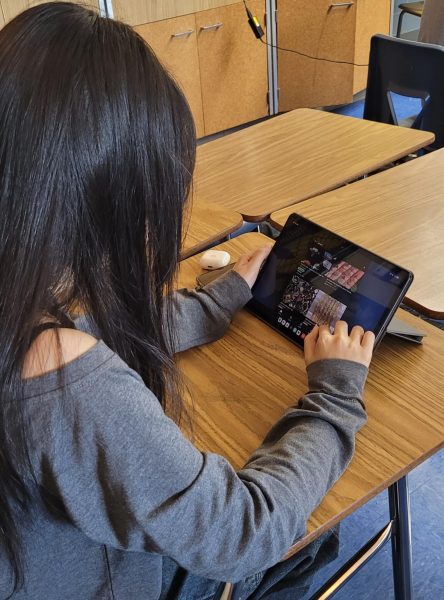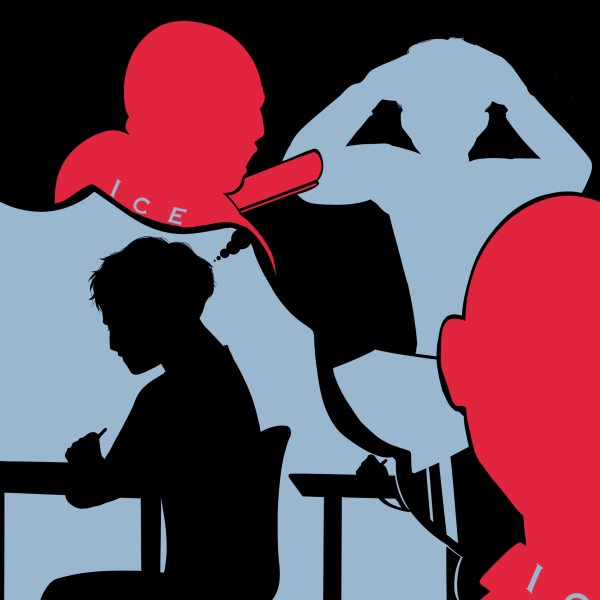Dress code enforcement draws debate among students and faculty
Some might say that these CHHS students (from left to right: Amara Thompson, Jeehan Mohamoud, Paris Whitney and Jonathon Heveron) are breaking the CHHS dress code.
As of now, there is no official dress code at Columbia Heights High School, as administration has not updated the 2020-21 Student Rights & Responsibilities Handbook for this school year. And the language used in that document simply defines a dress code violation as “attire or grooming which creates a danger to health or safety or creates a disruption to the educational process.” So it’s not about what’s deemed inappropriate by any individual, but rather what is dangerous and/or disrupts focusing on classwork and learning. Ironically, it seems that this school year, emphasis from some staff on girls’ and women’s choice of clothing is actually what’s disrupting the educational process — not the clothing choices themselves.
I should be clear: I have never heard of a student getting an official reprimand or being sent to the principal for their choice of clothing at CHHS. Instead, it is more so being told to not wear it in the future, to go change or put on an additional layer, or being asked to have one’s shirt covered with tape. So, where punishment might seem relatively harmless and easy to comply with, the focus should perhaps be on why we have a dress code in the first place.
It may not even be essential to have one, especially when the district’s mask mandate already largely covers the part of the code that prioritizes health and safety. And while the repercussions of dress code violations at CHHS might not be as severe as other schools that have been in the news recently, and yes, perhaps it’s not an issue that affects a lot of students here at Heights, but that does not mean it’s a small issue. What follows are the results of polling and interviewing various CHHS students and staff and their feelings about how the dress code is enforced.
Polling 49 CHHS students showed that 87 percent of young women and 73 percent of young men felt that the most targeted group of students who get dress coded are female students for showing too much skin over any other group and any other reason. When asked on the poll what they thought the reason was for having a dress code, 44 percent of female students said it was so that teachers don’t get distracted. In comparison, 26 percent believed it was to not be distracted by each other. The same amount of males tolling up to another 26 percent believed it was to teach professionalism to students. Ninety-four percent of students that responded selected all agreed that the dress code is targeted to the female gender.
Results of an open-ended questionnaire also showed how different genders view the dress code at school in general, with many female students believing it is to protect themselves from a society that teaches young women to cover up and be modest because men can’t keep themselves in check. Whereas for young men, some expressed that dress codes have taught them to not let their pants sag and not to wear hoodies, for it is seen as sloppy and unprofessional. Only four students total that answered the questionnaire declined to offer an opinion. When asked directly about his own experience with dress codes in the past, CHHS Principal Todd Wynne was happy to open up in an interview with The Heights Herald.
“I grew up in the 70s and 80s, so I am guilty of wearing the mesh crop top myself,” Wynne said.
So, what purpose does a dress code serve in a high school environment today if this has been an ongoing battle for decades in the American public education system? Who are we protecting by policing how much skin a student can or cannot show? Is it because it’s “unprofessional”? What exactly does that mean? Or maybe it’s because certain outfits are “distracting” to others.
“I am not certain that the word distraction is the right word we should be having this conversation about,” Wynne added.
No, it seems to him that the most common excuse teachers use when dress coding a student is not the right word. What about dressing to impress? That would surely sound nicer right? Well, that seems to be the case for our principal.
“I think we want kids to dress for success,” Wynne clarified. “If someone showed up to an interview here and they showed up wearing a tank top and blue jeans, more than likely that interview would be over before I even got to know that person.”
I do get that you should dress nicely for an interview, however not every day at school is an interview nor is it something everyone can afford. As a woman who has been “dress coded” in the past, it is now something I think about every time I go to pick an outfit for school. I am never trying to pick something that would disrupt anyone’s learning. I’m simply trying to pick something that makes me feel cute, comfortable and confident. I don’t know anyone who dresses themselves at the start of a day for any other reason.
“I think that Mr. Wynne’s revised dress code for this year made attempts at evening it out,” CHHS English teacher Ms. Mann said. “For example, the rule that nobody can show midriffs or their underwear so that covers both the girls wearing crop tops and the guys who sag their pants, so it seems a little more balanced.”
Efforts at equity among genders are appreciated, but this doesn’t change the fact that the student body’s perception is still that girls and women are targeted significantly more. This is a real problem not helped by the fact that all but one lead administrator in the building is female.
Once a teacher told me something that I have never forgotten: “I don’t have a problem with [the way you dress] — the patriarchy does.” I never forgot how that made me feel. I was so concerned about what I was wearing and that I would get in trouble, but she made me feel like she was okay with me. However, it did teach me something important that as a young adult I will carry with me for a very long time and that is that the dress code is something that schools should have gone away with long ago.
Even today I worry about what I wear. I can’t help the fact I am plus-sized. The clothes that are in trend are crop tops along with many cute shirts and clothes. Yet I am criticized daily by strangers and even people I am closest to. Judge about what I wear because I show too much. It bothers me because it lets me know we still live in a society where men can’t control themselves if they show too much skin. I am just a woman who’s grown up her whole life who had to cover up because it is dangerous if you don’t.
In the end, the dress code doesn’t mean people will respect you more, nor does it mean it keeps you safe from other people. What you wear does not define you. At least it shouldn’t, but it seems in this world what you wear makes you, you. So go shine like a star, wear every color of the rainbow or wear the shade of your favorite gray. Because this world might be built by them, but we get to make it ours. So go live, live for you and me; dress down or up.
After all, it is just a school dress code.

Haley Vogel is a Staff Writer for The Heights Herald. She is a hard-working and kind person who is passionate about poetry, student council, key club,...

Renee DeMars Dehn is currently a senior at Columbia Heights High School and the Co-Editor-in-Chief of The Heights Herald. This is their third year on the...







